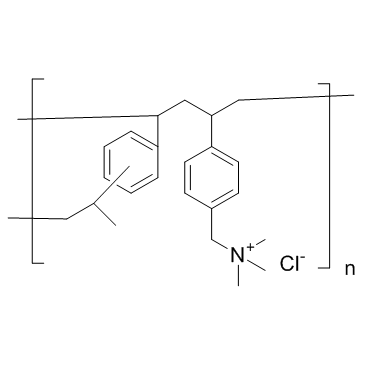Colestyramine (Cholestyramine resin) |
| Catalog No.GC32441 |
Colestyramine(콜레스티라민 수지)(Colestyramine)은 담즙산 결합 수지이며 장내 담즙산 흡수를 억제하여 콜레스테롤로부터 담즙산 합성을 증가시킬 수 있습니다.
Products are for research use only. Not for human use. We do not sell to patients.

Cas No.: 11041-12-6
Sample solution is provided at 25 µL, 10mM.
Colestyramine (Cholestyramine) is a bile acid binding resin and can inhibit intestinal bile acid absorption which results in the increasing bile acid synthesis from cholesterol.
Colestyramine (Cholestyramine) is a bile acid binding resin and can inhibit intestinal bile acid absorption which results in the increasing bile acid synthesis from cholesterol[1]. Results reveal that GSPE treatment alone, and co-administration with Colestyramine (CHY), regulate BA, cholesterol and TG metabolism differently compare to Colestyramine (CHY) administration alone. Notably, GSPE decreases intestinal apical sodium-dependent bile acid transporter (Asbt) gene expression, while Colestyramine (CHY) significantly induces expression. Administration with GSPE or Colestyramine (CHY) robustly induces hepatic BA biosynthetic gene expression, especially cholesterol 7α-hydroxylase (Cyp7a1), compare to control, while co-administration further enhances expression. Treatment with Colestyramine (CHY) induces both intestinal and hepatic cholesterologenic gene expression, while co-administration with GSPE attenuates the Colestyramine (CHY)-inducing increase in the liver but not in the intestine. Colestyramine (CHY) also induces hepatic lipogenic gene expression, which is attenuated by co-administration with GSPE[2].
[1]. Maugeais C, et al. rHDL administration increases reverse cholesterol transport in mice, but is not additive on top of ezetimibe or cholestyramine treatment. Atherosclerosis. 2013 Jul;229(1):94-101. [2]. Rebecca M. Heidker, et al. Grape Seed Procyanidins and Cholestyramine Differentially Alter Bile Acid and Cholesterol Homeostatic Gene Expression in Mouse Intestine and Liver. PLoS One. 2016; 11(4): e0154305.
Average Rating: 5 (Based on Reviews and 21 reference(s) in Google Scholar.)
GLPBIO products are for RESEARCH USE ONLY. Please make sure your review or question is research based.
Required fields are marked with *



















